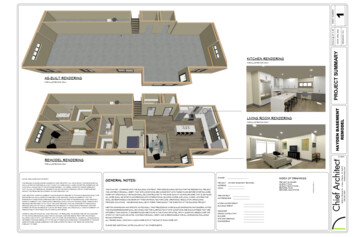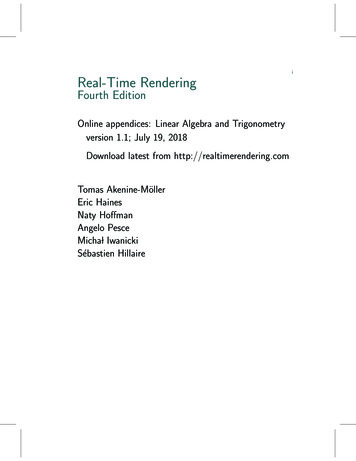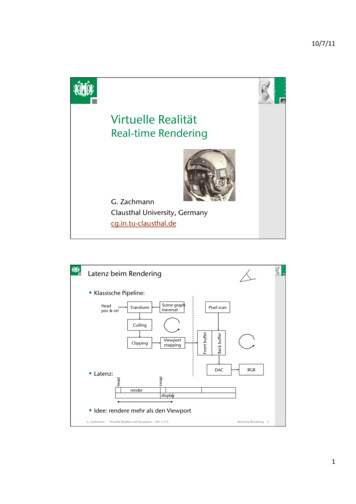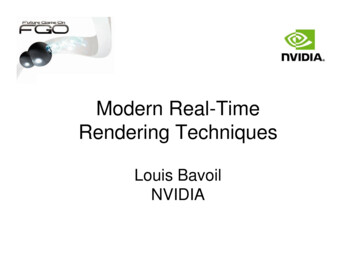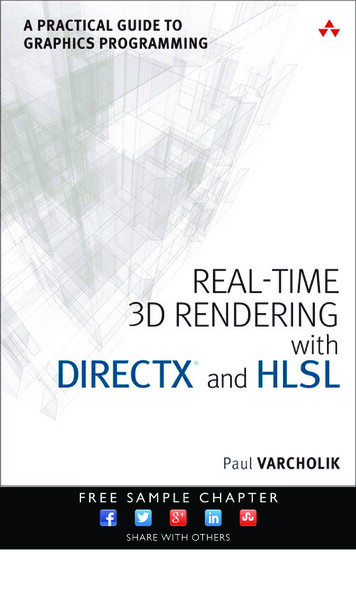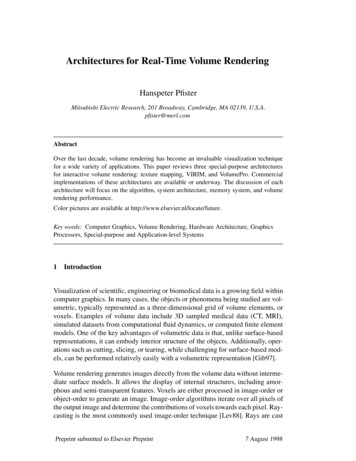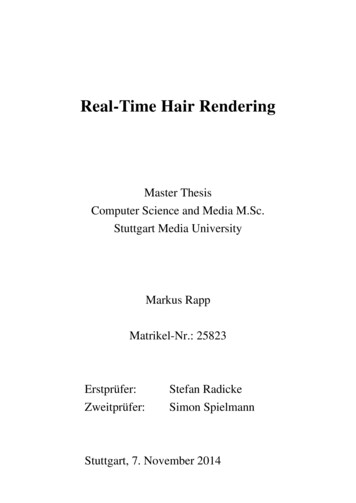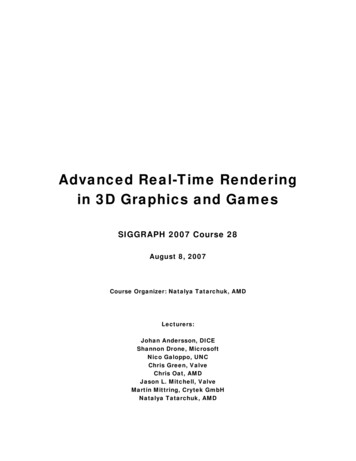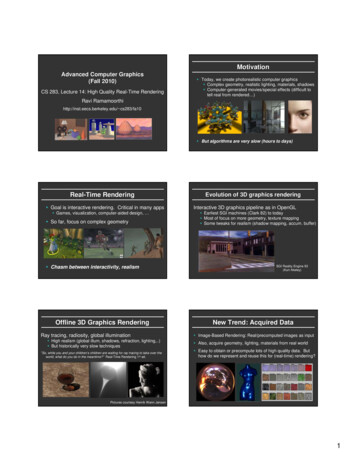
Transcription
MotivationAdvanced Computer Graphics(Fall 2010)CS 283, Lecture 14: High Quality Real-Time Rendering Today, we create photorealistic computer graphics Complex geometry, realistic lighting, materials, shadows Computer-generated movies/special effects (difficult totell real from rendered )Ravi Ramamoorthihttp://inst.eecs.berkeley.edu/ cs283/fa10 But algorithms are very slow (hours to days)RealReal-Time Rendering Goal is interactive rendering. Critical in many apps Games, visualization, computer-aided design, So far, focus on complex geometry Chasm between interactivity, realismOffline 3D Graphics RenderingRay tracing, radiosity, global illumination High realism (global illum, shadows, refraction, lighting,.) But historically very slow techniques“So, while you and your children’s children are waiting for ray tracing to take over theworld, what do you do in the meantime?” Real-Time Rendering 1st ed.Evolution of 3D graphics renderingInteractive 3D graphics pipeline as in OpenGL Earliest SGI machines (Clark 82) to today Most of focus on more geometry, texture mapping Some tweaks for realism (shadow mapping, accum. buffer)SGI Reality Engine 93(Kurt Akeley)New Trend: Acquired Data Image-Based Rendering: Real/precomputed images as input Also, acquire geometry, lighting, materials from real world Easy to obtain or precompute lots of high quality data. Buthow do we represent and reuse this for (real-time) rendering?Pictures courtesy Henrik Wann Jensen1
10 years ago High quality rendering: ray tracing, global illum., image-basedrendering (This is what a rendering course would cover) Real-Time rendering: Interactive 3D geometry with simpletexture mapping, maybe fake shadows (OpenGL, DirectX)Today Vast increase in CPU power, modern instrs (SSE, Multi-Core) Real-time raytracing techniques are possible (even onhardware: NVIDIA Optix) 4th generation of graphics hardware is programmable (First 3 gens were wireframe, shaded, textured) Modern nVidia, ATI cards allow vertex, fragment shaders Complex environment lighting, real materials (velvet, satin,paints), soft shadows, caustics often omitted in both Great deal of current work on acquiring and rendering withrealistic lighting, materials [Especially at Berkeley] Realism, interactivity at cross purposes Focus on quality of rendering, not quantity of polygons, textureGoals Overview of basic techniques for high-qualityreal-time renderingOutline Motivation and Demos Programmable Graphics Pipeline Shadow Maps Survey of important concepts and ideas, but donot go into details of writing code Environment Mapping Some pointers to resources, others on web One possibility for assignment 3, will need tothink about some ideas on your ownHigh quality realreal-time renderingHigh quality realreal-time rendering Photorealism, not just more polygons Photorealism, not just more polygons Natural lighting, materials, shadows Natural lighting, materials, shadowsGlass VaseInteriors by architect Frank Gehry. Note rich lighting, rangingfrom localized sources to reflections off vast sheets of glass.Glass Star (courtesy Intel)Peacock featherReal materials diverse and not easy to represent by simpleparameteric models. Want to support measured reflectance.2
High quality realreal-time renderingProgrammable Graphics Hardware Photorealism, not just more polygons Natural lighting, materials, shadowssmall area light, sharp shadows soft and hard shadowsAgrawala et al. 00Ng et al. 03Natural lighting creates a mix of soft diffuse and hard shadows.PrecomputationPrecomputation-Based MethodsRelit Images Static geometry Precomputation Real-Time Rendering (relight all-frequency effects) Involves sophisticated representations, algorithmsNg, Ramamoorthi, Hanrahan 04Video: RealReal-Time RelightingInteractive RayTracingAdvantages Very complex scenes relatively easy (hierarchical bbox) Complex materials and shading for free Easy to add global illumination, specularities etc.Disadvantages Hard to access data in memory-coherent way Many samples for complex lighting and materials Global illumination possible but expensiveModern developments: Leverage power of modern CPUs,develop cache-aware, parallel implementationsDemo http://www.youtube.com/watch?v blfxI1cVOzUFollowed by demo with real-time relighting with caustics3
OutlineBasic Hardware Pipeline Motivation and DemosApplication Programmable Graphics PipelineRasterizerGeometryGPUCPU Shadow Maps Environment MappingCreate geometry, lights,materials, textures,cubemaps, as inputsTransform and lighting calcs.Apply per-vertex operationsTextures, CubemapsPer-pixel (per-fragmentoperationsGeometry or Vertex PipelineModel, ViewTransformLightingProjectionClippingPixel or Fragment PipelineScreenRasterization(scan se fixed function stages can be replaced by a general per-vertexcalculation using vertex shaders in modern programmable hardwareThese fixed function stages are replaced by a general per-fragmentcalculation using fragment shaders in programmable hardwareShading LanguagesShader Setup Vertex / Fragment shading described by small program Written in language similar to C but with restrictions Long history. Cook’s paper on Shade Trees,Renderman for offline rendering Stanford Real-Time Shading Language, work at SGI Cg from NVIDIA, HLSL GLSL directly compatible with OpenGL 2.0 (So, you canjust read the OpenGL Red Book to get started)Cliff Lindsay web.cs.wpi.edu/ rich/courses/imgd4000-d09/lectures/gpu4
Cliff Lindsay web.cs.wpi.edu/ rich/courses/imgd4000-d09/lectures/gpuOutlineCliff Lindsay web.cs.wpi.edu/ rich/courses/imgd4000-d09/lectures/gpuShadow and Environment Maps Motivation and Demos Basic methods to add realism to interactive rendering Programmable Graphics Pipeline Shadow maps: image-based way to add hard shadows Very old technique. Originally Williams 78 Many recent (and older) extensions Widely used even in software rendering (RenderMan) Simple alternative to raytracing for shadows Shadow Maps Environment Mapping Environment maps: image-based complex lighting Again, very old technique. Blinn and Newell 76 Huge amount of recent work Together, give many of realistic effects we want But cannot be easily combined!!Common RealReal-time owvolumesMostly tricks with lots of limitations Projected planar shadowsworks well only on flat surfaces Stenciled shadow volumesdetermining the shadow volume is hard workHybridapproaches Light mapstotally unsuited for dynamic shadows In general, hard to get everything shadowing everythingLight mapsThis slide, others courtesy Mark Kilgard5
Shadow Mapping Lance Williams: Brute Force in image space(shadow maps in 1978, but other similarideas like Z buffer, bump mapping usingtextures and so on)Phase 1: Render from Light Depth image from light source Completely image-space algorithm no knowledge of scene’s geometry is required must deal with aliasing artifacts Well known software rendering technique Basic shadowing technique for Toy Story, etc.Phase 1: Render from Light Depth image from light sourcePhase 2: Render from Eye Standard image (with depth) from eyeEyePhase 2 : Project to light for shadowsPhase 2 : Project to light for shadows Project visible points in eye view back to light source Project visible points in eye view back to light sourceEye(Reprojected) depths match for light and eye. VISIBLEEye(Reprojected) depths from light, eye not the same. BLOCKED!!6
Visualizing Shadow MappingVisualizing Shadow Mapping A fairly complex scene with shadowsthe pointlight sourcewith shadowsVisualizing Shadow Mapping The scene from the light’s point-of-viewVisualizing Shadow Mapping The depth buffer from the light’s point-of-viewFYI: from theeye’eye’s pointpoint-ofof-viewagainVisualizing Shadow Mapping Projecting the depth map onto the eye’s viewFYI: depth map forlight’light’s pointpoint-ofof-viewagainwithout shadowsFYI: from thelight’light’s pointpoint-ofof-viewagainVisualizing Shadow Mapping Comparing light distance to light depth mapGreen iswhere thelight planardistance andthe lightdepth mapareapproximately equalNonNon-green iswhereshadowsshould be7
Visualizing Shadow Mapping Scene with shadowsHardware Shadow Map Filtering Normal texture filtering just averages colorcomponents Averaging depth values does NOT workNotice howcurvedsurfaces castshadows oneach otherNotice howspecularhighlightsnever appearin shadowsHardware Shadow Map FilteringGL NEAREST: blockyGL LINEAR: antialiased edges “Percentage Closer” filtering [Reeves 87] Hardware performs comparison for each sample Then, averages results of comparisons Provides anti-aliasing at shadow map edges Not soft shadows for umbra/penumbra case But often used to fake soft shadowsProblems with shadow maps Hard shadows (point lights only) Quality depends on shadow map resolution(general problem with image-based techniques) Involves equality comparison of floating point depthvalues means issues of scale, bias, toleranceLow shadow map resolutionused to heighten filtering artifactsOutline Many recent extensionsReflection Maps Motivation and Demos Programmable Graphics Pipeline Shadow Maps Environment MappingBlinn and Newell, 19768
Environment MapsEnvironment MapsMiller and Hoffman, 1984Later, Greene 86, Cabral et al, Debevec 97, Interface, Chou and Williams (ca. 1985)Environment MapsReflectance Maps Reflectance Maps (Index by N) Cylindrical Panoramas Irradiance (N) and Phong (R) Reflection Maps Cubical Environment Map180 degree fisheyePhoto by R. PackoIrradiance Environment MapsRHorn, 1977Miller and Hoffman, 1984Mirror SphereChrome SphereMatte SphereAssumptionsN Diffuse surfaces Distant illumination No shadowing, interreflectionHence, Irradiance a function of surface normalIncident Radiance(Illumination Environment Map)Irradiance Environment Map9
Diffuse ReflectionAnalytic Irradiance FormulaB E Reflectance(albedo/texture)Radiosity(image intensity)Irradiance(incoming light)Lambertian surfaceacts like low-pass filterElm Al Llmquake light mapRamamoorthi and Hanrahan 01Basri and Jacobs 019 Parameter Approximationl12xy-20yzxyz3z 2 1zx-10Al 2 l l! ( 1) (l 2)(l 1) 2l 2l ! 2 l 12l evenOrder 14 termsExact imageYlm ( , )mRMS error 25 % /49 Parameter ApproximationOrder 01 termExact image0Al0 1 2 2 / 3RMS Error 8%l12x2 y221Ylm ( , )m0xy-29 Parameter Approximationyzxyz3z 2 1zx-10x2 y212RealReal-Time RenderingtE (n) n MnExact image0xy-2yzxyz3z 2 1zx-101Widely used in Games (AMPED for MicrosoftXbox), Movies (Pixar, Framestore CFC, )surface float1 irradmat (matrix4 M, float3 v) {float4 n {v , 1} ;l1For any illumination, averageerror 3% [Basri Jacobs 01] 2 Requires only matrix-vector multiply and dot-product In software or NVIDIA vertex programming hardwareYlm ( , )mRMS Error 1%Simple procedural rendering method (no textures)Order 29 termsreturn dot(n , M*n) ;x2 y22}10
Environment Map Summary Very popular for interactive rendering Extensions handle complex materials Shadows with precomputed transferResources OpenGL red book (latest includes GLSL) Web tutorials: http://www.lighthouse3d.com/opengl/glsl/ Older books: OpenGL Shading Language book (Rost),The Cg Tutorial, http://www.realtimerendering.com Real-Time Rendering by Moller and Haines But cannot directly combine with shadow maps Limited to distant lighting assumption Debevec http://www.debevec.org/ReflectionMapping/ Links to Miller and Hoffman original, Haeberli/Segal http://www.cs.berkeley.edu/ ravir/papers/envmap Also papers by Heidrich, Cabral, Lots of information available on web 11
Real-Time Rendering (relight all-frequency effects) Involves sophisticated representations, algorithms Relit Images Ng, Ramamoorthi, Hanrahan 04 Video: Real-Time Relighting Followed by demo with real-time relighting with caustics Interactive RayTracing Advantages Very complex scenes relatively easy (hierarchical bbox) Complex materials and shading for free Easy to add global illumination .
